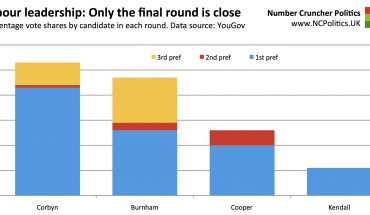I've been meaning to do some analysis of the Greens for a while and given today's polling, now seems like a good time. Ipsos-MORI reported a topline rating of 9%, the highest Green score since 1989. The “likely voter” figure, which is included in the headline graphics though not officially the topline itself, showed 10%, only 3 points from third place. Elsewhere, Lord Ashcroft’s constituency polling included Brighton Pavilion, where the closely-watched ‘second question’ had Caroline Lucas ten points clear of Labour.
Greens at record high; main party shares remain low https://t.co/diZDkSdPNh pic.twitter.com/MvnBHOxvG0
— Ipsos MORI (@IpsosMORI) December 18, 2014
Before anyone gets carried away, a couple of words of caution. Ipsos-MORI, who don’t prompt for any party in their question, have shown most of the higher Green ratings this year. Lord Ashcroft has also had the Greens on 8% nationally and tends to show among the lowest scores for Labour (and the Conservatives).
Nevertheless, these are strong numbers and the direction of the trend is clearly up. Monthly averages of YouGov polls suggest that the Greens have now overtaken the Lib Dems. So how far could they go? A large proportion of the Greens’ support has come from 2010 Lib Dem voters. With the Lib Dems collapsing into the single digits (and the low single digits in many constituencies), some have taken this to mean that the ceiling on the Green vote might be close. What this ignores, however, is the huge number of 2010 Lib Dems who now say “don’t know”, which some pollsters have routinely put at over 30% (or about 7% of all 2010 voters).
To illustrate the point, a panel survey (with weighting) by the Guardian of their own readership showed a sharp increase in Green support, with only fractions coming from other parties and nearly all coming from “Don’t know”.
From Guardian panel survey, demographically weighted, N=635. High Green% no surprise, but note the speed of the surge pic.twitter.com/hQV63Nu5cr
— NumbrCrunchrPolitics (@NCPoliticsUK) December 16, 2014
Hollowing out the Lib Dems (or attempting to) is quite an efficient way of turning votes into seats (or attempting to) because Lib Dem votes have become increasingly concentrated in favourable areas, which bodes well for (mostly future) seat-winning opportunities, something which I’ll look at more in a future piece. But as the chart below illustrates, since July an increasing share has come from former Labour voters and even a few ex-Tories. As polling has shown, there are plenty of Labour voters who would consider voting Green.
Could the Green vote be squeezed tactically? A piece by YouGov CEO Stephan Shakespeare in the Times suggested that a third of Greens might tactically vote Labour. However I’m a bit concerned that the question, which reads “How do you predict you will actually end up voting? This may not be for your favourite party but for your tactical choice” might be more than a bit leading. Lord Ashcroft’s latest poll also included 8 LAB-CON marginals (the seats where tactical voting might actually happen) from around England and Wales and found that, in aggregate, only 0.5% of all voters (11% of Green voters) switched from Green to Labour when asked specifically to consider their own constituency and the candidates likely to stand there. But those seats might not be representative of all marginals, so this remains an open question.
Comparisons have been made to the heady summer of 1989, when the Greens, having been endorsed by a raft of celebrities and the Today newspaper, rode a wave of environmental concerns to third place in the European elections with 14.9% of the vote. Their poll rating soared to an average of 8.8% in July, with 13% from the now defunct phone pollster Audience Selection Limited proving to be the all-time high watermark. Then, as now, there was considerable variation among pollsters, but among the established houses NOP showed 10% twice. But by the next general election in 1992, support had collapsed to 0.5%, as poor organisation and a shift in the political agenda from the environment to the economy as the recession hit, took their toll.
Going purely by the data, this Green surge looks nothing like 1989 (which, incidentally, was before 21% of likely Green voters in today’s poll were born). The surge has actually been rather steady growth, not a sudden spike that by this point had already collapsed to half what it was. There are other factors in the Greens’ favour that weren’t present a quarter of a century ago, such as social media (including crowd funding) and an environment less favourable to ‘establishment’ parties. Next stop, double figures.
Number Cruncher would like to thank Ben Foley for some very useful background relating to this piece.





